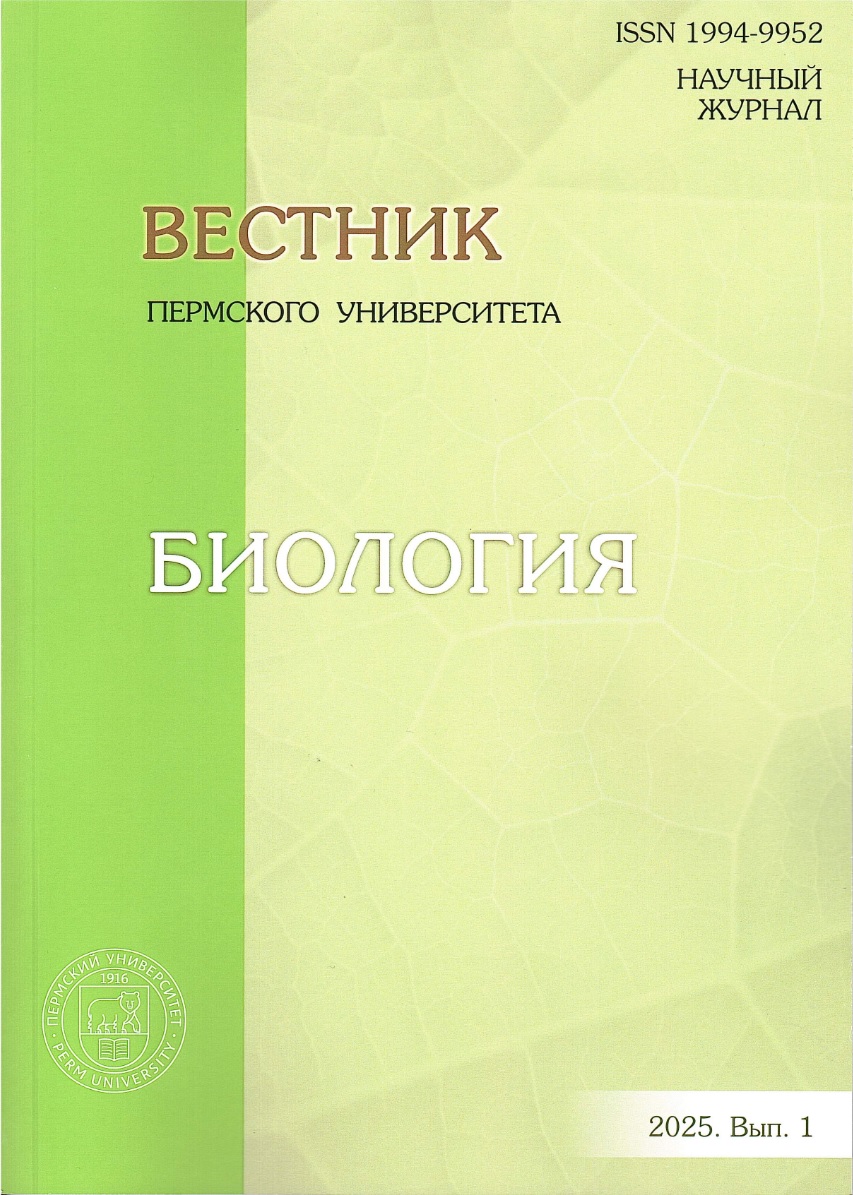Modeling of the protein structure of the α-subunit of biphenyl 2,3- dioxygenase (BphA1) of the R. wratislaviensis strain CH628
Main Article Content
Abstract
Article Details
References
Ananina L.N. et al. Naphthalene-degrading bacteria of the genus Rhodococcus from the Verkhnekamsk salt mining region of Russia // Antonie van Leeuwenhoek. 2011. Vol. 100. Р. 309–316. doi: 10.1007/s10482-011-9580-3. EDN: OHZMXD
Anokhina T.O. et al. Alternative naphthalene metabolic pathway includes formation of ortho-phthalic ac-id and cinnamic acid derivatives in the Rhodococcus opacus strain 3D // Biochemistry (Moscow). 2020. Vol. 85. Р. 355–368. doi: 10.1134/S0006297920030116. EDN: MHPAVJ
Baratto M.C. et al. Spectroscopic characterisation of the naphthalene dioxygenase from Rhodococcus sp. strain NCIMB12038 // International Journal of Molecular Sciences. 2019. Vol. 20, № 14. Art. 3402. doi: 10.3390/ijms20143402.
Castro A.R. et al. Rhodococcus opacus B4: a promising bacterium for production of biofuels and bi-obased chemicals // AMB Express. 2016. Vol. 6. P. 1−11. doi: 10.1186/s13568-016-0207-y. EDN: GZKDLZ
Colbert C.L. et al. Structural characterization of Pandoraea pnomenusa B-356 biphenyl dioxygenase re-veals features of potent polychlorinated biphenyl-degrading enzymes // PLoS One. 2013 Vol. 8, № 1. Art. e52550. doi: 10.1371/journal.pone.0052550.
Colovos C, Yeates T.O. Verification of protein structures: patterns of nonbonded atomic interactions // Protein Science. 1993. Vol. 2, № 9. Р. 1511–1519. doi: 10.1002/pro.5560020916.
Dhindwal S. et al. Structural basis of the enhanced pollutant-degrading capabilities of an engineered bi-phenyl dioxygenase // Journal of Bacteriology. 2016. Vol. 198, № 10. Р. 1499–1512. doi: 10.1128/jb.00952-15.
Egorova D.O. et al. Bioremediation of hexachlorocyclohexane-contaminated soil by the new Rhodococ-cus wratislaviensis strain Ch628 // Water Air Soil Pollution. 2017. Vol. 228. Р. 183–199. doi: 10.1007/s11270-017-3344-2. EDN: YVIWTP
Egorova, D.O. et al. Biodegradability of hydroxylated derivatives of commercial polychlorobiphenyls mixtures by Rhodococcus-strains // Journal of Hazardous Materials. 2020. Vol. 400. Art. 123328. doi: 10.1016/j.jhazmat.2020.123328. EDN: YAMJTU
Furusawa Y. et al. Crystal Structure of the Terminal Oxygenase Component of Biphenyl Dioxygenase Derived from Rhodococcus sp. Strain RHA1 // Journal of Molecular Biology. 2004. Vol. 342, № 3. Р. 1041–1052. doi: 10.1016/j.jmb.2004.07.062. EDN: KFOYKL
Gorbunova T.I. et al. Degradability of commercial mixtures of polychlorobiphenyls by three Rhodococ-cus strains // Archives of Microbiology. 2022. Vol. 204. Art. 534. doi: 10.1007/s00203-022-03131-1.
Gorbunova, T.I. et al. Biodegradation of trichlorobiphenyls and their hydroxylated derivatives by Rho-dococcus strains // Journal of Hazardous Materials. 2021. Vol. 409. Art. 124471. doi: 10.1016/j.jhazmat.2020.124471. EDN: QHUUIH
Jones D.T. et al. MetaPSICOV: combining coevolution methods for accurate prediction of contacts and long range hydrogen bonding in proteins // Bioinformatics. 2015. Vol. 31, № 7. Р. 999–1006. doi: 10.1093/bioinformatics/btu791.
Kuhlman B., Bradley P. Advances in protein structure prediction and design // Nature Reviews Molecular Cell Biology. 2019. Vol. 20, № 11. Р. 681–697. doi: 10.1038/s41580-019-0163-x. EDN: IJAOHN
Lüthy R., Bowie J.U. Eisenberg D. Assessment of protein models with three-dimensional profiles // Na-ture. 1992. Vol. 356, № 6364. Р. 83–85. doi: 10.1038/356083a0.
Na K.S. et al. Isolation and characterization of benzene-tolerant Rhodococcus opacus strains. // Journal of Bioscience and Bioengineering. 2005. Vol. 99, № 4. Р. 378–382. doi: 10.1263/jbb.99.378.
Tian W.et al. CASTp 3.0: computed atlas of surface topography of proteins // Nucleic Acids Research. 2018. Vol. 4, № W1. Р. W363–W367. doi: 10.1093/nar/gky473.
Wang S. et al. Accurate de novo prediction of protein contact map by ultra-deep learning model // PLoS Computational Biology. 2017. Vol. 13, № 1. Art. e1005324. doi: 10.1371/journal.pcbi.1005324.
Wang Y et al. The engineered biphenyl dioxygenases enhanced the metabolism of dibenzofuran // Inter-national Biodeterioration and Biodegradation. 2021. Vol. 161. Art. 105228. doi: 10.1016/j.ibiod.2021.105228. EDN: BVRXVY
Zhu L. et al. Degradation mechanism of biphenyl and 4,4’-dichlorobiphenyl cis-dihydroxylation by non-heme 2,3 dioxygenases BphA: A QM/MM approach // Chemosphere. 2020. Vol. 247. Art. 125844. doi: 10.1016/j.chemosphere.2020.125844. EDN: UMRTTC




